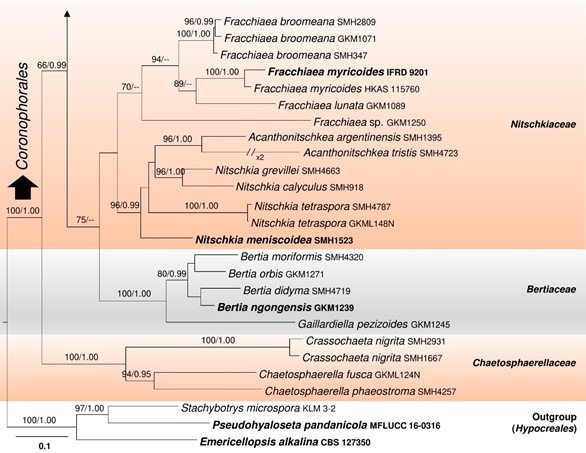Yuxiensis Bundhun & K.D. Hyde, gen. nov.
Index Fungorum number: IF 558675; Facesoffungi number: FoF 10184
Etymology:–Referring to the city Yuxi in China.
Saprobic on dead wood.
Sexual morph: Ascomata immersed to erumpent, appearing superficial on worn off substrate, astromatic to stromatic, aggregated, black, non-ostiolate, semi-globose when fresh, collapsing when dry, without hair or bristles, subiculum in- conspicuous, coriaceous. Ascomatal wall comprising 2–3 types of layers; outermost layer heavily pigmented, composed of thick-walled, very dark brown cells, inner layer compris- ing thick-walled cells of textura globulosa to textura angularis, innermost layer composed of flattened, thin-walled cells of textura prismatica toward the locule; Munk pores visible, few per cell. Hamathecium composed of large, subcylindrical quellkörper, attached to the roof of the centrum and extending until base of the ascoma; paraphyses indistinct. Asci 8-spored, unitunicate, clavate, long-pedicellate, rounded at apex, lacking an apical ring, thin-walled, evanescent. Ascospores irregularly arranged, cylindrical to allantoid, hyaline, aseptate, with granular contents, lacking mucilaginous sheath or appendage.
Asexual morph: Undetermined.
Type: Yuxiensis granularis Bundhun, Wanas. & K.D. Hyde
Notes: – Yuxiensis is introduced in Scortechiniaceae as a new quellkörper-bearing taxon distinct from all other genera in the family, based on LSU, ITS, tef1 and rpb2 sequence data. The new genus has a close phylogenetic affinity to Pseudocatenomycopsis even though this relationship is not statistically significant (Figure 1). This low support may possibly be accounted for by insufficient taxon sampling. Nevertheless, the new taxon being intro- duced in the present study constantly clusters with Pseudocatenomycopsis in all phylogenies (single, not shown; and concatenated, Figure 1). The asexual morph for Yuxiensis could not be obtained in the present study. It thus cannot be morphologically compared with Pseudocatenomycopsis, which has been described in its asexual morph only. Pseudocatenomy- copsis has been introduced from Zambia as a saprobe on the stem of Rothmannia engleriana (Rubiaceae) [11]. The new genus is also phylogenetically close to Euacanthe (Figure 1). It morphologically differs from Euacanthe in terms of ascomatal position and surface as well as ascospore ornamentation [12,43].

Figure 1. Cont.

Figure 1. Phylogram generated from maximum likelihood (RAxML) based on LSU–ITS–tef1–rpb2 matrix for Coronophorales. The tree is rooted with Emericellopsis alkalina (CBS 127350), Pseudohyaloseta pandanicola (MFLUCC 16-0316) and Stachybotrys microspora (KLM 3-2). Maximum likelihood bootstrap (≥65) and BYPP (≥0.95) supports are shown, respectively, above or below the branches. Type strains are in bold while novelty and the recombined taxon are in blue.
Species
